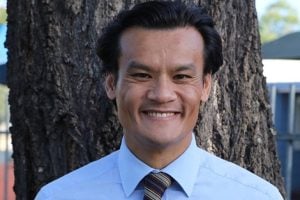Startups, technology, innovation, investment and modern manufacturing are no longer on the priority list in NSW.
Technology, startups and the arts are esoteric areas of investment for the new NSW Labor government and will bear the brunt of cost cutting and budget savings in the years ahead as part of a drive to surplus.
Among a range of cuts on multiple fronts in the first budget from new treasurer Daniel Mookhey was the demise of the $703 million Future Economy Fund former treasurer Matt Kean launched just 15 months ago as “a once-in-a-generation chance” in the 2022 budget.
The fund was created to back fast-growing local companies in the medtech, digital tech and the clean economy. It was meant to be for “strategic interventions across the life cycle of a business and its products” to drive productivity in emerging high-value industries. Instead, Labor is redirecting up to $360 million to funding 1000 apprenticeships and budget savings.
The word “startup” only appears twice in NSW Budget Paper No. 1 in a reference to the Sydney Startup Hub rental subsidy, which supported tenants through the pandemic lockdowns. The line item reports $0 in FY24.
That’s the only time they’re mentioned across all the budget papers.
Labor’s first NSW budget in 13 years is very much meat-and-two-veg – a back-to-basics of state government while also pushing for “back in black” post-Covid surpluses.
Public sector workers such as nurses and teachers received deserved wages increases after years of austerity, costing around $3.6 billion. There $72.3bn for transport infrastructure; a $9.8 billion for schools and TAFE building works; $1.8 billion for renewable energy zones and an energy security corp; $700 million for regional roads, and $2.2 billion for housing and infrastructure. The deficit for this year, FY24, is predicted to be $7.8 billion, but by FY25, it’s an annual surplus for three years: $844 million, then $1.6bn surplus in FY26; and $1.5 bn in FY27.
The Sydney Startup Hub survives, as we reported ahead of the budget. But like a $190 million cut in arts and culture funding Labor blamed on its predecessors a few days beforehand, the new government made a conscious decision to not restore the funding.
A pattern
Since coming to power in March, Labor’s been on a go slow when it comes to the startup sector.
Most controversially, we’re still waiting to see what happens with the highly successful minimum viable products (MVP) grant program after it was halted in May.
A leading fintech founder called it a kick in the guts for the startup sector.
Four months later, it’s still on hold “as part of the sector-wide Comprehensive Expenditure Review being coordinated by NSW Treasury”. The assumption was it would be completed in time for the September budget. But it wasn’t.
The $10 million Carla Zampatti VC fund to back women founders remains in stasis 15 months after the former government announced it, even as the pioneering Victorian version of this initiative LaunchVic’s Alice Anderson Fund, continues to kick goals leveraging private sector funding to co-invest in more than 25 startups led by women.
For such a nominal level of funding – the cost of a skinny 3br house in Manly with harbour views – you wonder why the government is so slow to act.
The $11 million Tech Central rental rebate scheme has had no new recipients in the six months since Labor came to power, with $5.2 million in funding under the program unallocated before it shut down in June.
Yes, there have been some initiatives, but many were already in train such as a $7.8 million into new biomedical incubator in Western Sydney, the Techstars Tech Central program and next month’s tech, innovation, music, film and gaming festival South by Southwest Sydney.
Investment NSW cuts
Meanwhile, Investment NSW, the government organisation charged with supporting many of these initiatives, is shedding around a quarter of its workforce.
Just 48 hours after the budget, the Department of Enterprise, Investment and Trade (DEIT), which is charged with driving “the NSW Government’s commitment to economic transformation and thriving communities in NSW” told staff at Investment NSW last Thursday that it’s being restructured with 75 roles going, The SMH reports.
DEIT saw its funding fall by 10% between FY23 and this financial year, while the tourism body Destination NSW took a $109 million hit, with its budget dropping from $382m last financial year to $274 million in FY24
Among other cuts, the EV incentives – rebates and stamp duty exemptions – put in place by the former government wind up after two years at the end of 2023.
But what about casinos?
Deficit pressures and the wise use of money is a key theme for the government, so amid the scramble to save money, one decision stands out.
There’s good news for a company that ran a casino so badly that inquiries concluded its unfit to hold its licence in NSW and Queensland, and federal regulators allege broke anti-money laundering laws.
But the NSW government is here to help, cutting The Star’s tax bill by more than $300 million over the next four years to ensure its “ongoing financial viability”.
Incidentally, that’s three times the size of the fine Star Entertainment Group paid for its regulatory failings.
The decision was made last month before the budget and relates to a cut in the increased poker machine tax the former government introduced following the company’s casino licence breaches.
The Star was threatening to close its Sydney business. In return for the reductions it has guaranteed 3000 jobs until 2030 – so more than $100,000 a job.
That figure is less than 1% of total employment in the NSW startup ecosystem.
And you could chalk up that decision as a broken election promise by Labor.
A new blueprint!
Late last week you may have heard a huge cheer from the NSW tech ecosystem thanks to wondrous news from innovation, science and technology minister Anoulack Chanthivong.

NSW innovation, science and technology minister Anoulack Chanthivong
“We support a strong innovation sector that delivers new, higher paid and productive jobs in high growth industries,” he said.
The minister went on to explain that anything that’s gone wrong so far is the Coalition’s fault.
“The last government treated multi-million dollar grants as great headlines but beyond the spin they failed to fully fund their own programs and failed to treat taxpayer money with the respect it deserves,” he said.
So the exciting news is that NSW is going to get an “Innovation Blueprint”.
“Getting this right will help us foster a strong innovation sector, create the industries that will fuel the jobs of the future, and attract talent,” Chanthivong said.
This shouldn’t be confused with the NSW Innovation Strategy, released in 2016.
Like a bonus episode of Utopia, the minister is promising to “lead roundtables, including on venture capital, non-monetary government support, how to best encourage startup growth, industry adoption of innovation and attraction of skills and talent” as part of the blueprint process.
“The Innovation Blueprint will be drafted alongside sector leaders and experts to give NSW the leading edge in the global battle to attract new investment, ideas, industries and talent,” his media release said, adding that “despite millions of dollars spent by the last government, NSW lacks clear guiding principles, strategic direction or metrics to measure the impact this funding has had”.
The announcement goes on to warn that “there’s no room in the Budget for spending that might not be delivering for the people of NSW”.
Read the reviews
You have to feel sorry for the team at Investment NSW, now being decimated, who’ve spent years publishing analysis and reports that address precisely these issues.
The 2018 Innovation Economy: Implications and Imperatives for States and Regions report commissioned by the Innovation and Productivity Council, offers a roadmap – dare we say a blueprint – on the way forward for innovation, looking at international examples to outline how “government’s role is to ‘nudge’ the market to intervene effectively in five main ways”.
Then there’s a report on lessons for NSW innovation precincts from international experiences.
Talent, minister? Yes, there’s an 88-page report on that too: Global talent wars: learning from locations that attract the best as well as an Investment NSW response to the Innovation and Productivity Council’s report.
The minister bemoans that “R&D intensity is in freefall”.
Perhaps he hasn’t had a chance to read the office of the NSW Chief Scientist’s work for the NSW 20-Year R&D Roadmap, released in May 2022, which emerged from the Turning ideas into jobs: Accelerating R&D in NSW Action Plan.
That roadmap “sets out a 20-year vision for NSW to produce more world-leading new technologies, products and services, and develop and sustain globally competitive advantages and future industries”.
It has four technology themes – Digital, Chemistry and Materials, Biotechnology, Energy – “and 39 technology applications across a range of sectors in which NSW has aggregated competitive advantages versus domestic and international peers”.
Minister Chanthivong should also have a look at the annual NSW Innovation and Productivity Scorecard (IPS), last produced by Investment NSW in 2022 (a digital version was meant to be out this year), which rates NSW well ahead of international rivals in areas such as university education, published papers and researchers, startup founders, digital capability, and GDP growth.
But guess what key area NSW is well behind its international rivals on?
If you said “government investment in R&D”, something the Treasurer and innovation minister could have been addressed in the budget, but didn’t, then congrats.
Chanthivong’s release says: “The Innovation Blueprint will put us in the best position to jump start innovation in new sectors and in important enabling technologies like quantum computing, artificial intelligence, data, cyber, sensors and robotics across sectors like energy, advanced manufacturing, healthcare and agrifood, all of which will be part of our future economic growth.”
The existing NSW Innovation Strategy was designed to complement the federal government’s 2015 National Innovation and Science Agenda (aka the Turnbull era “ideas boom”), which covers exactly these areas.
NSW has already identified its priority technology sectors and they include AI and data services, quantum computing, fintech, cybersecurity, virtual reality and digital gaming. There’s a whole NSW Emerging Technologies Strategy, released in January this year.
Back before the March election, we asked both sides of politics to outline their policies for startups.
The then-Labor spokesperson didn’t really have anything to say, and her successor appears to be living up to that promise.
Does the sector need yet another review? Federally, startups are still waiting for Ed Husic to act, nearly halfway through the government’s first term, amid countless reviews and programs in abeyance.
For startups, it’s all about speed. For governments, top speed is glacial.
TCA weighs in
What’s happened in NSW saw the Tech Council of Australia weigh in, which is notable for a peak body normally focused on federal issues.

Tech Council of Australia CEO Kate Pounder
NSW is home to around 40% of Australia’s startup ecosystem, currently generating 342,000 jobs and contributing $67 billion to the state’s economy. It’s hoped to be a key driver of jobs growth in the sector over the next several years, providing around 160,000 jobs by 2030 (for perspective, 53x The Star casino jobs guarantee).
TCA CEO Kate Pounder said clarity around support from the government is urgent for NSW companies “under funding pressure for the last year due to uncertainty in the investment market and pauses to both federal Industry Department and NSW state grants programs following elections in both jurisdictions” warning that NSW startups could be left at a disadvantage compared to other states.
“We recommend that the government work with the industry to quickly clarify what grant funding is available, and how companies can apply for it, to minimise the impact of the changes on the industry to provide certainty for businesses accessing funding,” she said.
“We welcome the Innovation Blueprint process as it provides the opportunity to develop a sustainable future funding model. Speed is of the essence in ensuring that a funding gap doesn’t open up for innovative businesses in NSW.
“It is important the Government works with the industry as a priority to look at funding models in NSW, and how it can remain competitive versus other states. This should include exploring VC style funding models – in addition to grants programs – as pioneered by Victoria and Queensland.”
The best example of what Pounder’s talking about is already there, awaiting action – the proposed Carla Zampatti fund.
Benchmarks
Startups are used to having to meet milestones for investors. There are some simple ones the NSW government will need to meet and beat to prove it’s more walk than talk.
The world is watching too.
Sydney currently sits at 20 in the Startup Genome rankings of global ecosystems. The government-backed Sydney Startup Hub, Western Sydney Startup Hub, and Tech Central Scaleup Hub are hailed as key indicators of a supportive environment.
Sydney also sits in the top 20 globally for funding and top 25 for talent and experience, and performance. The total ecosystem is valued at US$78 billion – twice the global average.Startupblink has Sydney at 38th globally, just ahead of Melbourne at 42nd.
For the next 3.5 years of the Minns government, where Sydney sits on those benchmarks will be the report card on the efforts of minister Anoulack Chanthivong and Labor in supporting NSW startups.
And as HSC students will know shortly, the time comes when you have to stop studying and sit the test.
Or to put it another way, after so long in opposition, becoming a government minister is not when you lift the hood to stare at the engine. It’s when you need to get in the car and drive.




















Trending
Daily startup news and insights, delivered to your inbox.